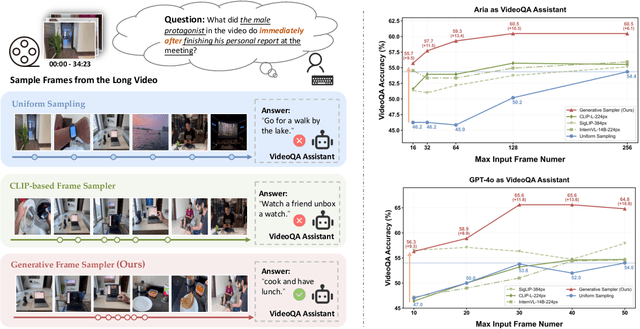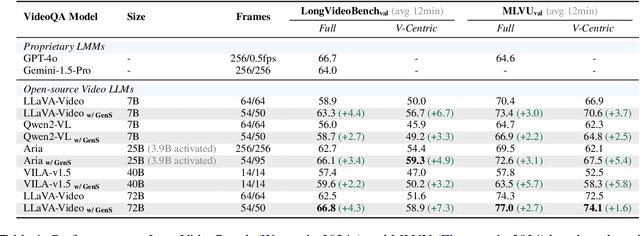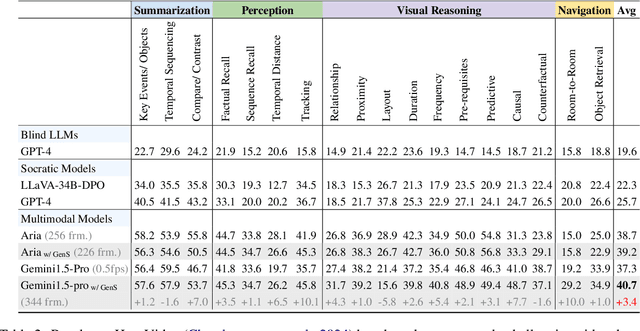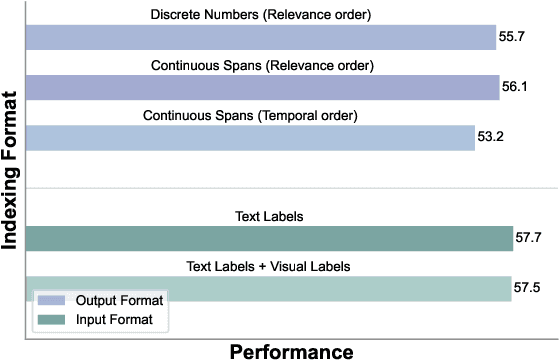Xu Sun
Conan: Progressive Learning to Reason Like a Detective over Multi-Scale Visual Evidence
Oct 23, 2025Abstract:Video reasoning, which requires multi-step deduction across frames, remains a major challenge for multimodal large language models (MLLMs). While reinforcement learning (RL)-based methods enhance reasoning capabilities, they often rely on text-only chains that yield ungrounded or hallucinated conclusions. Conversely, frame-retrieval approaches introduce visual grounding but still struggle with inaccurate evidence localization. To address these challenges, we present Conan, a framework for evidence-grounded multi-step video reasoning. Conan identifies contextual and evidence frames, reasons over cross-frame clues, and adaptively decides when to conclude or explore further. To achieve this, we (1) construct Conan-91K, a large-scale dataset of automatically generated reasoning traces that includes frame identification, evidence reasoning, and action decision, and (2) design a multi-stage progressive cold-start strategy combined with an Identification-Reasoning-Action (AIR) RLVR training framework to jointly enhance multi-step visual reasoning. Extensive experiments on six multi-step reasoning benchmarks demonstrate that Conan surpasses the baseline Qwen2.5-VL-7B-Instruct by an average of over 10% in accuracy, achieving state-of-the-art performance. Furthermore, Conan generalizes effectively to long-video understanding tasks, validating its strong scalability and robustness.
Spatial-Temporal Human-Object Interaction Detection
Aug 24, 2025Abstract:In this paper, we propose a new instance-level human-object interaction detection task on videos called ST-HOID, which aims to distinguish fine-grained human-object interactions (HOIs) and the trajectories of subjects and objects. It is motivated by the fact that HOI is crucial for human-centric video content understanding. To solve ST-HOID, we propose a novel method consisting of an object trajectory detection module and an interaction reasoning module. Furthermore, we construct the first dataset named VidOR-HOID for ST-HOID evaluation, which contains 10,831 spatial-temporal HOI instances. We conduct extensive experiments to evaluate the effectiveness of our method. The experimental results demonstrate that our method outperforms the baselines generated by the state-of-the-art methods of image human-object interaction detection, video visual relation detection and video human-object interaction recognition.
VideoReasonBench: Can MLLMs Perform Vision-Centric Complex Video Reasoning?
May 29, 2025Abstract:Recent studies have shown that long chain-of-thought (CoT) reasoning can significantly enhance the performance of large language models (LLMs) on complex tasks. However, this benefit is yet to be demonstrated in the domain of video understanding, since most existing benchmarks lack the reasoning depth required to demonstrate the advantages of extended CoT chains. While recent efforts have proposed benchmarks aimed at video reasoning, the tasks are often knowledge-driven and do not rely heavily on visual content. To bridge this gap, we introduce VideoReasonBench, a benchmark designed to evaluate vision-centric, complex video reasoning. To ensure visual richness and high reasoning complexity, each video in VideoReasonBench depicts a sequence of fine-grained operations on a latent state that is only visible in part of the video. The questions evaluate three escalating levels of video reasoning skills: recalling observed visual information, inferring the content of latent states, and predicting information beyond the video. Under such task setting, models have to precisely recall multiple operations in the video, and perform step-by-step reasoning to get correct final answers for these questions. Using VideoReasonBench, we comprehensively evaluate 18 state-of-the-art multimodal LLMs (MLLMs), finding that most perform poorly on complex video reasoning, e.g., GPT-4o achieves only 6.9% accuracy, while the thinking-enhanced Gemini-2.5-Pro significantly outperforms others with 56.0% accuracy. Our investigations on "test-time scaling" further reveal that extended thinking budget, while offering none or minimal benefits on existing video benchmarks, is essential for improving the performance on VideoReasonBench.
RICO: Improving Accuracy and Completeness in Image Recaptioning via Visual Reconstruction
May 28, 2025Abstract:Image recaptioning is widely used to generate training datasets with enhanced quality for various multimodal tasks. Existing recaptioning methods typically rely on powerful multimodal large language models (MLLMs) to enhance textual descriptions, but often suffer from inaccuracies due to hallucinations and incompleteness caused by missing fine-grained details. To address these limitations, we propose RICO, a novel framework that refines captions through visual reconstruction. Specifically, we leverage a text-to-image model to reconstruct a caption into a reference image, and prompt an MLLM to identify discrepancies between the original and reconstructed images to refine the caption. This process is performed iteratively, further progressively promoting the generation of more faithful and comprehensive descriptions. To mitigate the additional computational cost induced by the iterative process, we introduce RICO-Flash, which learns to generate captions like RICO using DPO. Extensive experiments demonstrate that our approach significantly improves caption accuracy and completeness, outperforms most baselines by approximately 10% on both CapsBench and CompreCap. Code released at https://github.com/wangyuchi369/RICO.
TimeChat-Online: 80% Visual Tokens are Naturally Redundant in Streaming Videos
Apr 24, 2025Abstract:The rapid growth of online video platforms, particularly live streaming services, has created an urgent need for real-time video understanding systems. These systems must process continuous video streams and respond to user queries instantaneously, presenting unique challenges for current Video Large Language Models (VideoLLMs). While existing VideoLLMs excel at processing complete videos, they face significant limitations in streaming scenarios due to their inability to handle dense, redundant frames efficiently. We introduce TimeChat-Online, a novel online VideoLLM that revolutionizes real-time video interaction. At its core lies our innovative Differential Token Drop (DTD) module, which addresses the fundamental challenge of visual redundancy in streaming videos. Drawing inspiration from human visual perception's Change Blindness phenomenon, DTD preserves meaningful temporal changes while filtering out static, redundant content between frames. Remarkably, our experiments demonstrate that DTD achieves an 82.8% reduction in video tokens while maintaining 98% performance on StreamingBench, revealing that over 80% of visual content in streaming videos is naturally redundant without requiring language guidance. To enable seamless real-time interaction, we present TimeChat-Online-139K, a comprehensive streaming video dataset featuring diverse interaction patterns including backward-tracing, current-perception, and future-responding scenarios. TimeChat-Online's unique Proactive Response capability, naturally achieved through continuous monitoring of video scene transitions via DTD, sets it apart from conventional approaches. Our extensive evaluation demonstrates TimeChat-Online's superior performance on streaming benchmarks (StreamingBench and OvOBench) and maintaining competitive results on long-form video tasks such as Video-MME and MLVU.
UVE: Are MLLMs Unified Evaluators for AI-Generated Videos?
Mar 13, 2025Abstract:With the rapid growth of video generative models (VGMs), it is essential to develop reliable and comprehensive automatic metrics for AI-generated videos (AIGVs). Existing methods either use off-the-shelf models optimized for other tasks or rely on human assessment data to train specialized evaluators. These approaches are constrained to specific evaluation aspects and are difficult to scale with the increasing demands for finer-grained and more comprehensive evaluations. To address this issue, this work investigates the feasibility of using multimodal large language models (MLLMs) as a unified evaluator for AIGVs, leveraging their strong visual perception and language understanding capabilities. To evaluate the performance of automatic metrics in unified AIGV evaluation, we introduce a benchmark called UVE-Bench. UVE-Bench collects videos generated by state-of-the-art VGMs and provides pairwise human preference annotations across 15 evaluation aspects. Using UVE-Bench, we extensively evaluate 16 MLLMs. Our empirical results suggest that while advanced MLLMs (e.g., Qwen2VL-72B and InternVL2.5-78B) still lag behind human evaluators, they demonstrate promising ability in unified AIGV evaluation, significantly surpassing existing specialized evaluation methods. Additionally, we conduct an in-depth analysis of key design choices that impact the performance of MLLM-driven evaluators, offering valuable insights for future research on AIGV evaluation. The code is available at https://github.com/bytedance/UVE.
Generative Frame Sampler for Long Video Understanding
Mar 12, 2025



Abstract:Despite recent advances in Video Large Language Models (VideoLLMs), effectively understanding long-form videos remains a significant challenge. Perceiving lengthy videos containing thousands of frames poses substantial computational burden. To mitigate this issue, this paper introduces Generative Frame Sampler (GenS), a plug-and-play module integrated with VideoLLMs to facilitate efficient lengthy video perception. Built upon a lightweight VideoLLM, GenS leverages its inherent vision-language capabilities to identify question-relevant frames. To facilitate effective retrieval, we construct GenS-Video-150K, a large-scale video instruction dataset with dense frame relevance annotations. Extensive experiments demonstrate that GenS consistently boosts the performance of various VideoLLMs, including open-source models (Qwen2-VL-7B, Aria-25B, VILA-40B, LLaVA-Video-7B/72B) and proprietary assistants (GPT-4o, Gemini). When equipped with GenS, open-source VideoLLMs achieve impressive state-of-the-art results on long-form video benchmarks: LLaVA-Video-72B reaches 66.8 (+4.3) on LongVideoBench and 77.0 (+2.7) on MLVU, while Aria obtains 39.2 on HourVideo surpassing the Gemini-1.5-pro by 1.9 points. We will release all datasets and models at https://generative-sampler.github.io.
Next Block Prediction: Video Generation via Semi-Autoregressive Modeling
Feb 12, 2025Abstract:Next-Token Prediction (NTP) is a de facto approach for autoregressive (AR) video generation, but it suffers from suboptimal unidirectional dependencies and slow inference speed. In this work, we propose a semi-autoregressive (semi-AR) framework, called Next-Block Prediction (NBP), for video generation. By uniformly decomposing video content into equal-sized blocks (e.g., rows or frames), we shift the generation unit from individual tokens to blocks, allowing each token in the current block to simultaneously predict the corresponding token in the next block. Unlike traditional AR modeling, our framework employs bidirectional attention within each block, enabling tokens to capture more robust spatial dependencies. By predicting multiple tokens in parallel, NBP models significantly reduce the number of generation steps, leading to faster and more efficient inference. Our model achieves FVD scores of 103.3 on UCF101 and 25.5 on K600, outperforming the vanilla NTP model by an average of 4.4. Furthermore, thanks to the reduced number of inference steps, the NBP model generates 8.89 frames (128x128 resolution) per second, achieving an 11x speedup. We also explored model scales ranging from 700M to 3B parameters, observing significant improvements in generation quality, with FVD scores dropping from 103.3 to 55.3 on UCF101 and from 25.5 to 19.5 on K600, demonstrating the scalability of our approach.
VidTwin: Video VAE with Decoupled Structure and Dynamics
Dec 23, 2024Abstract:Recent advancements in video autoencoders (Video AEs) have significantly improved the quality and efficiency of video generation. In this paper, we propose a novel and compact video autoencoder, VidTwin, that decouples video into two distinct latent spaces: Structure latent vectors, which capture overall content and global movement, and Dynamics latent vectors, which represent fine-grained details and rapid movements. Specifically, our approach leverages an Encoder-Decoder backbone, augmented with two submodules for extracting these latent spaces, respectively. The first submodule employs a Q-Former to extract low-frequency motion trends, followed by downsampling blocks to remove redundant content details. The second averages the latent vectors along the spatial dimension to capture rapid motion. Extensive experiments show that VidTwin achieves a high compression rate of 0.20% with high reconstruction quality (PSNR of 28.14 on the MCL-JCV dataset), and performs efficiently and effectively in downstream generative tasks. Moreover, our model demonstrates explainability and scalability, paving the way for future research in video latent representation and generation. Our code has been released at https://github.com/microsoft/VidTok/tree/main/vidtwin.
PunchBench: Benchmarking MLLMs in Multimodal Punchline Comprehension
Dec 16, 2024



Abstract:Multimodal punchlines, which involve humor or sarcasm conveyed in image-caption pairs, are a popular way of communication on online multimedia platforms. With the rapid development of multimodal large language models (MLLMs), it is essential to assess their ability to effectively comprehend these punchlines. However, existing benchmarks on punchline comprehension suffer from three major limitations: 1) language shortcuts that allow models to solely rely on text, 2) lack of question diversity, and 3) narrow focus on a specific domain of multimodal content (e.g., cartoon). To address these limitations, we introduce a multimodal \textbf{Punch}line comprehension \textbf{Bench}mark, named \textbf{PunchBench}, which is tailored for accurate and comprehensive evaluation of punchline comprehension. To enhance the evaluation accuracy, we generate synonymous and antonymous captions by modifying original captions, which mitigates the impact of shortcuts in the captions. To provide a comprehensive evaluation, PunchBench incorporates diverse question formats and image-captions from various domains. On this basis, we conduct extensive evaluations and reveal a significant gap between state-of-the-art MLLMs and humans in punchline comprehension. To improve punchline comprehension, we propose Simple-to-Complex Chain-of-Question (SC-CoQ) strategy, enabling the models to incrementally address complicated questions by first mastering simple ones. SC-CoQ effectively enhances the performance of various MLLMs on PunchBench, surpassing in-context learning and chain-of-thought.
 Add to Chrome
Add to Chrome Add to Firefox
Add to Firefox Add to Edge
Add to Edge